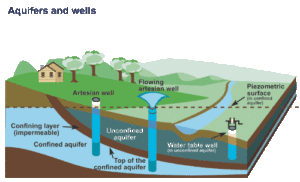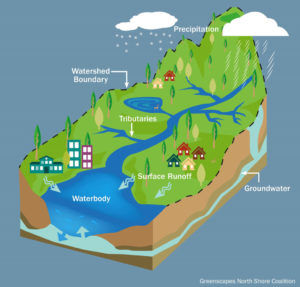Key Terms & Concepts
Washington Water Law—starting with the passage of the state’s first water law in 1917—has been established over the past century through a piecewise accumulation of legislation, resulting in a convoluted and often contradictory mess. So before you dive in to the resources provided below, please take a moment to brush up on your Water Law jargon.
Adjudication
A court proceeding which effectively brings all water users in a watershed into one lawsuit to fully determine everyone’s water rights legally and permanently. Water rights adjudications most frequently arise where water rights are over-appropriated. The proceedings are costly and cumbersome; for example, the Yakima basin adjudication took 42 years during which 4,000 claims to water were reviewed.
You can read about CELP’s efforts to ensure the Nooksack Basin adjudication here.
Aquifers & Groundwater
Aquifers are underground layers of rock saturated with water; groundwater refers to the water contained within the aquifer. Groundwater can only be accessed through natural springs or brought to the surface through pumping via a well. Groundwater is one of the most important sources of water on Earth: about 30 percent of our liquid freshwater is groundwater, according to the National Oceanic and Atmospheric Administration (NOAA).
Read about CELP’s advocacy and policy work to protect our aquifers here.

Beneficial Use
“Use it or lose it”; one of two fundamental principles that govern water rights. Beneficial Use is the both the requirement to put water to reasonable use without waste to create the basis for the water right, and the measure or limit of that water right.
Department of Ecology (Ecology / DOE)
The Washington State Department of Ecology (often referred to a ‘Ecology’ or ‘DOE’) is our state’s environmental regulatory agency. Created in February 1970, it was the first environmental regulation agency in the U.S. predating the creation of the federal Environmental Protection Agency (EPA) by several months.
As a part of their responsibilities, Ecology manages the state’s water supply—such as evaluating and issuing water rights, permitting, leading the adjudication process, monitoring compliance, etc.—to meet the needs of people and the natural environment, in partnership with Washington communities.
Four-Part-Test
When evaluating water right applications, the four-part test requires Ecology to determine:
- Water is available (physically and legally)
- Water will be applied to a beneficial use
- There will be no impairment (negative effects) to existing rights
- The proposed use will not be detrimental to the public interest
Hydraulic Continuity
The interconnection between groundwater (aquifers) and surface water sources. An aquifer is in hydraulic continuity with wetlands, lakes, streams, rivers or other surface water bodies whenever it is discharging to these water bodies. Continuity also exists when an aquifer is being recharged by surface water. Hydraulically connected ground water and surface water cannot be considered as independent resources because a withdrawal from one will have an effect on the other.
Impairment
‘Impairment’ is a key concept in Washington water law, an aspect of the prior appropriation doctrine that protects existing water rights. Impairment occurs when the use of a junior water right (one that came later in time) takes water away from a senior water right. Furthermore, as part of the “Four-Part-Test” in evaluating water right applications, new water uses and water right transfers cannot negatively impact, or impair, existing water users.
Instream Flow
An instream flow is essentially a water right granted to the river itself. Since the adoption of Washington’s Water Resources Act in 1971, legal recognition of instream water uses to preserve fish, wildlife, and other environmental values have become firmly entrenched in Washington water law. By establishing “instream flow rules,” rules that require a certain amount of water to be left in streams before water may be withdrawn for any new uses, the Washington State Department of Ecology (Ecology) must protect the environment while also managing water to achieve “maximum net benefits” for the people of Washington State. Ecology may only allow new withdrawals of water that will impair established instream flows if it finds that “overriding considerations of the public interest” will be served.
You can read more about CELP’s work to protect instream flows in rivers throughout the state here.


Mitigation Water
Mitigation is an important resource management technique used to avoid, minimize, or compensate for
impacts of a water use. As the climate crisis and population growth lead to Washington increasingly lacking water where and when it is needed for communities and the environment, it is often difficult to find water for new uses in many parts of the state. Mitigation may allow Ecology to approve a water right application where otherwise it would be denied. Under Washington water law, mitigation must include an environmental cost-benefit analysis, and must address water availability or otherwise offset any adverse impacts.
There are many types of mitigation and they are evaluated on a case-by-case basis. Types of mitigation include:
- Water-for-Water/In-Kind: Replacement water is similar in quantity, timing and location; *preferred form of mitigation
- Out-of-Time: Provide the same amount of water, but shift the time when water is present in a
stream - Out-of-Place: Provide the same amount of water, but shift the location of water in a stream
- Out-of-Kind: Non-water mitigation such as protection or enhancement of riparian or recharge
areas
You can read about some of CELP’s litigation and advocacy work preventing abuse of the mitigation strategy here and here.
Pollution Control Hearings Board (PCHB)
Created in 1970, hears and decides appeals from state and local governmental agencies on a wide variety of environmental permits or penalty orders. (RCW 43.21B.110). The PCHB has three members, appointed by the governor, and confirmed by the State Senate for staggered six-year terms. One of the three must be an attorney.
Prior Appropriation
“First in time means first in right”; one of two fundamental principles that govern water rights in Washington. Prior Appropriation means that the older (senior) water right has priority over more recent (junior) rights irrespective of their relative social importance. In times of shortage, a senior water right can receive its full allocation, before junior water rights receive anything.
Surface Water
Any body of water above ground, including streams, rivers, lakes, ponds, wetlands, reservoirs, and creeks. The ocean, despite being saltwater, is also considered surface water.
Fresh surface waters are especially important as they sustain ecological systems and provide habitat for many plant and animal species. They also support a myriad of human uses, including drinking water, irrigation, wastewater treatment, livestock, industrial uses, hydropower, and recreation.
Water Right
In 1917, the Washington state passed its first water law, establishing that those who first put water to a good use retain the right to continue using it in the future. Washington waters belong to the public and can’t be owned by any individual or group. Instead, a person or group may be granted a right to use a volume of water, for a defined purpose, in a specific place.
Water rights in Washington follow the principles of ‘prior appropriation’ and ‘beneficial use’, which essentially means when it comes to rights, “first in time, means first in right” and “use it, or lose it”.
Only a few uses don’t require a permit, such as domestic and industrial use of less than 5,000 gallons per day.
Watershed
The term ‘watershed’ refers to an area of land that channels snow melt and precipitation to creeks, streams, and rivers, and eventually to an outflow, such as ground water, a bay, or the ocean.

Water Resource Inventory Area (WRIA)
The state of Washington is divided into 62 separate WRIAs, the boundaries of which are defined by watersheds. Washington’s 62 WRIAs were created as a result of the Water Resources Act of 1971 and updated with the adoption of the Watershed Management Act of 1998 which established the Watershed Planning Program. The purpose of the act was to encourage the development of comprehensive, long-range watershed planning through voluntary collaborative efforts at the watershed level. The watershed plans must, at a minimum, address short-term and long-term concerns related to water quantity in order to qualify for state funding. Watersheds were also encouraged, but not required, to address planning needs related to instream flows, water quality, and habitat. The Department of Ecology was—and still is—responsible for the development and management of these administrative and planning boundaries. Between 1998 and 2012, 44 watershed-based planning groups developed plans and 33 groups adopted their plans.
You can read about CELP’s policy and advocacy work dedicated to the ongoing update of watershed plans here.

Additional Resources & Topics to Explore







